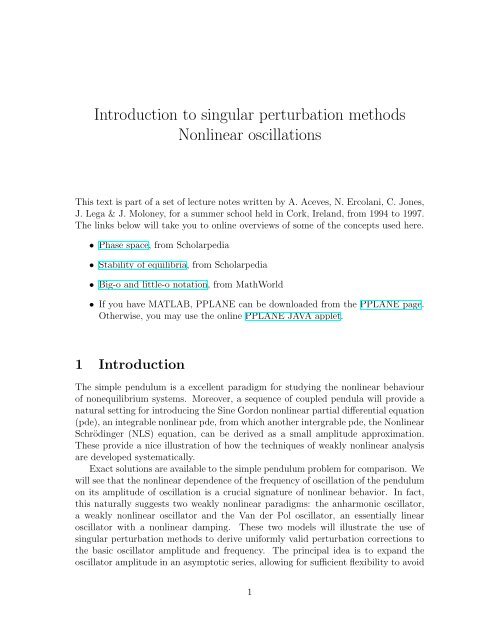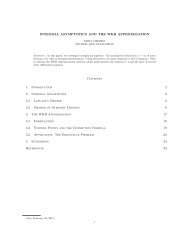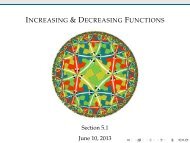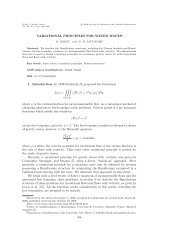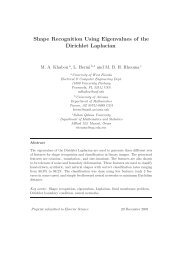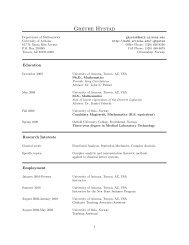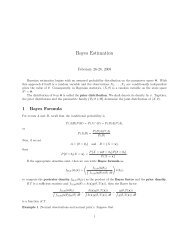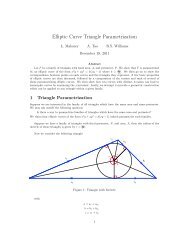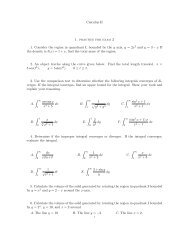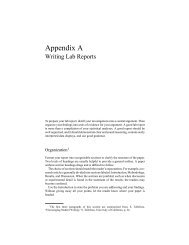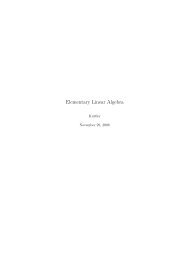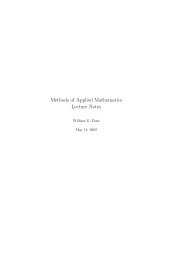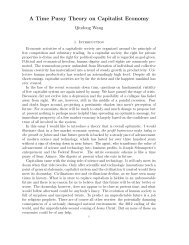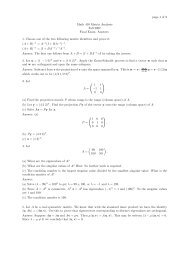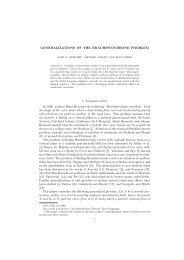Introduction to singular perturbation methods Nonlinear oscillations
Introduction to singular perturbation methods Nonlinear oscillations
Introduction to singular perturbation methods Nonlinear oscillations
You also want an ePaper? Increase the reach of your titles
YUMPU automatically turns print PDFs into web optimized ePapers that Google loves.
<strong>Introduction</strong> <strong>to</strong> <strong>singular</strong> <strong>perturbation</strong> <strong>methods</strong><br />
<strong>Nonlinear</strong> <strong>oscillations</strong><br />
This text is part of a set of lecture notes written by A. Aceves, N. Ercolani, C. Jones,<br />
J. Lega & J. Moloney, for a summer school held in Cork, Ireland, from 1994 <strong>to</strong> 1997.<br />
The links below will take you <strong>to</strong> online overviews of some of the concepts used here.<br />
• Phase space, from Scholarpedia<br />
• Stability of equilibria, from Scholarpedia<br />
• Big-o and little-o notation, from MathWorld<br />
• If you have MATLAB, PPLANE can be downloaded from the PPLANE page.<br />
Otherwise, you may use the online PPLANE JAVA applet.<br />
1 <strong>Introduction</strong><br />
The simple pendulum is a excellent paradigm for studying the nonlinear behaviour<br />
of nonequilibrium systems. Moreover, a sequence of coupled pendula will provide a<br />
natural setting for introducing the Sine Gordon nonlinear partial differential equation<br />
(pde), an integrable nonlinear pde, from which another intergrable pde, the <strong>Nonlinear</strong><br />
Schrödinger (NLS) equation, can be derived as a small amplitude approximation.<br />
These provide a nice illustration of how the techniques of weakly nonlinear analysis<br />
are developed systematically.<br />
Exact solutions are available <strong>to</strong> the simple pendulum problem for comparison. We<br />
will see that the nonlinear dependence of the frequency of oscillation of the pendulum<br />
on its amplitude of oscillation is a crucial signature of nonlinear behavior. In fact,<br />
this naturally suggests two weakly nonlinear paradigms: the anharmonic oscilla<strong>to</strong>r,<br />
a weakly nonlinear oscilla<strong>to</strong>r and the Van der Pol oscilla<strong>to</strong>r, an essentially linear<br />
oscilla<strong>to</strong>r with a nonlinear damping. These two models will illustrate the use of<br />
<strong>singular</strong> <strong>perturbation</strong> <strong>methods</strong> <strong>to</strong> derive uniformly valid <strong>perturbation</strong> corrections <strong>to</strong><br />
the basic oscilla<strong>to</strong>r amplitude and frequency. The principal idea is <strong>to</strong> expand the<br />
oscilla<strong>to</strong>r amplitude in an asymp<strong>to</strong>tic series, allowing for sufficient flexibility <strong>to</strong> avoid<br />
1
unbounded (secular) growth of the correction term <strong>to</strong> the amplitude at each order in<br />
the <strong>perturbation</strong> expansion. We will first see how a regular <strong>perturbation</strong> expansion<br />
lacks this flexibility.<br />
Singular <strong>perturbation</strong> expansions are extremely powerful analytic <strong>to</strong>ols for studying<br />
a whole class of nonlinear problems. They will form the basis for deriving many<br />
of the hierarchy of soli<strong>to</strong>n equations (the <strong>Nonlinear</strong> Schrödinger equation (NLS), in<br />
particular) and universal order parameter equations (of Complex Ginzburg-Landau<br />
type) valid near a bifurcation point in spatially extended systems. As these <strong>perturbation</strong><br />
theories involve expansions in a small parameter, one might be left with the<br />
impression that they are of limited utility. Remarkably, in many instances the results<br />
prove accurate even for values of the parameter approaching O(1).<br />
The equation of motion for a simple pendulum is expressed in terms of the rate<br />
of change of the angle of the pendulum, measured with respect <strong>to</strong> its equilibrium<br />
position,<br />
¨θ + ω 2 sin θ = 0,<br />
ω =<br />
√ g<br />
l .<br />
Multiplying by ˙θ gives<br />
or<br />
˙θ¨θ + ω 2 ˙θ sin θ = 0<br />
d<br />
dθ (1 2 ˙θ 2 − ω 2 cos θ) = 0,<br />
1<br />
2 ˙θ 2 − ω 2 cos θ = c, a constant,<br />
which is a statement of the conservation of energy. The phase portrait of the simple<br />
pendulum is the graph of ˙θ vs. θ for different values of the arbitrary constant c. This<br />
yields the one-parameter family of curves graphed in Figure 1.<br />
The arrows indicate how θ is changing: ˙θ > 0 ⇒ θ is increasing and, ˙θ < 0 ⇒ θ<br />
is decreasing. Such a graph conveniently summarizes all possible states of motion of<br />
the pendulum.<br />
The pendulum has the advantage that an exact solution can be obtained and<br />
expressed in terms of elliptic functions. This, however, is not very illuminating. For<br />
example the period of oscillation is given by:<br />
P eriod = 4 ω<br />
∫ π/2<br />
0<br />
dψ<br />
√<br />
, m 2 = sin 2 A<br />
1 − m 2 sin 2 ψ<br />
2 ,<br />
where A denotes the maximum amplitude of the motion. Note that the period (frequency)<br />
is amplitude dependent.<br />
2
2<br />
dθ/dt<br />
0<br />
-2<br />
-5 0 5 10<br />
θ<br />
Figure 1:<br />
Phase portrait of the simple pendulum.<br />
Exercise: Derive the above equation for the period of the pendulum.<br />
For the phase portrait analysis, let θ = x, ˙θ = y. Then, the system reads<br />
ẋ = y<br />
ẏ = −ω 2 sin x.<br />
Critical (equilibrium) points occur when (ẋ, ẏ) = (0, 0).<br />
Exercise: Using the software package PPLANE, construct phase portraits for nonlinear<br />
dynamical systems such as the simple pendulum.<br />
We now review some important consequences of nonlinearity on the dynamics of<br />
oscilla<strong>to</strong>rs.<br />
• The frequency of oscillation depends on the amplitude of the swing.<br />
• Tracing out separatrices takes infinite time.<br />
• When externally driven, hysteresis may occur between different states of oscillation,<br />
thereby leading <strong>to</strong> the coexistence of multiple states.<br />
We noted above that the pendulum equation cannot be solved in terms of elementary<br />
functions. For relatively small displacements from equilibrium one can<br />
expand sin θ ≃ θ − θ 3 /3!.... The lowest truncation ¨θ + ω 2 θ = 0 yields the simple<br />
harmonic oscilla<strong>to</strong>r, a linear system. The solution of this differential equation is simply<br />
θ(t) = a cos ωt + b sin ωt, with a and b arbitrary constants. At the next level<br />
3
2<br />
1<br />
dθ/dt<br />
0<br />
-1<br />
-2<br />
-2 -1 0 1 2<br />
θ<br />
Figure 2: Phase portrait of the anharmonic oscilla<strong>to</strong>r (ω 2 = 1, ɛ = 1).<br />
of truncation we obtain the anharmonic oscilla<strong>to</strong>r, ¨θ + ω 2 θ = ω2<br />
6 θ3 which exhibits<br />
nonlinear behavior. If we think of the anharmonic term as a small (ɛ) correction <strong>to</strong><br />
simple harmonic motion, we can replace ω2<br />
6 by ɛ<br />
¨θ + ω 2 θ = ɛθ 3 .<br />
This is also the nonlinear spring model with a res<strong>to</strong>ring force F = −kx + k ′ x 3 where<br />
θ now represents the displacement of the spring from equilibrium, ω 2 = k/m and<br />
ɛ = k ′ /m.<br />
The phase portraits of anharmonic oscilla<strong>to</strong>rs are sketched by first writing the<br />
above as a system y = ˙θ, x = θ<br />
ẋ = y<br />
ẏ = −ω 2 x + ɛx 3<br />
and then obtaining the critical points by setting (ẋ, ẏ) = (0, 0).<br />
This yields the<br />
equilibria as solutions of → y = 0; x(ɛx 2 − ω 2 ) = 0. These are y = 0 and x = 0, ± √ ω ɛ<br />
1 (see Figure 2).<br />
For a realistic physical description we typically need <strong>to</strong> add a frictional force<br />
proportional <strong>to</strong> the velocity. We now consider two types of damping, linear and<br />
nonlinear. The anharmonic oscilla<strong>to</strong>r with linear damping is simply<br />
ẍ + δẋ + ω 2 x = ɛx 3<br />
1 If ɛ < 0 (hard spring) only the origin is a critical point. We observe the same qualitative behavior<br />
as the pendulum.<br />
4
2<br />
dx/dt<br />
0<br />
-2<br />
-2 -1 0 1 2<br />
x<br />
Figure 3: Phase portrait of the Van der Pol oscilla<strong>to</strong>r (ω 2 = 1, ɛ = 1).<br />
This equation exhibits a simple stable (attracting) critical point and two unstable<br />
equilibria. This can be inferred geometrically from its associated phase portraits.<br />
Exercise: Use PPLANE <strong>to</strong> draw the phase portraits of the damped anharmonic<br />
oscilla<strong>to</strong>r.<br />
A linear oscilla<strong>to</strong>r with nonlinear damping is given by the Van der Pol equation<br />
ẍ + ω 2 x + ɛ(x 2 − 1)ẋ = 0<br />
Here the damping coefficient depends on the amplitude x(t) and displays a very<br />
interesting behavior depending on the magnitude of the displacement x. If |x| < 1,<br />
we obtain negative damping or growth, and, if |x| > 1, the damping is positive or<br />
the solution decays. We can immediately infer from this observation that the Van<br />
der Pol equation possesses a stable limit cycle solution (see Figure 3).<br />
Exercise: Use PPLANE <strong>to</strong> construct a phase portrait of the Van der Pol oscilla<strong>to</strong>r<br />
for different magnitudes of the “small” parameter ɛ = 0.01, 0.1, and 1.0.<br />
We will first proceed <strong>to</strong> analyze the Van der Pol oscilla<strong>to</strong>r for ɛ
as the leading order behavior. Our starting equation is<br />
ẍ + x + ɛ(x 2 − 1)ẋ = 0 ɛ
Here A 1 and B 1 are arbitrary constants of integration. Note that the term t cos t<br />
causes the solution <strong>to</strong> grow without bound as t → ∞. In fact, <strong>to</strong> this order,<br />
x(t) = B 0 cos t +<br />
[ ] B<br />
3<br />
0<br />
4 − B 0 (− ɛt cos t)<br />
2<br />
− B3 0<br />
32 ɛ sin 3t + ɛB 1 cos t + ɛA 1 sin t<br />
Therefore, when t is O(1/ɛ) the <strong>perturbation</strong> expansion, which assumes that each<br />
term of the series is smaller than the preceding one, breaks down. This unbounded<br />
growth term leads <strong>to</strong> secular divergence of the solution. Since we are looking for a<br />
periodic solution, such secular terms must be removed. If we choose B 0 = 2, this<br />
term vanishes at this order at least.<br />
We now apply the initial condition x ′ 1(0) = 0.<br />
x ′ 1(t) = − 24<br />
32 cos 3t − B 1 sin t + A 1 cos t<br />
x ′ 1(0) = − 3 4 + A 1 = 0 or A 1 = 3/4<br />
Therefore,<br />
x 1 (t) = − 1 4 sin 3t + 3 4 sin t + B 1 cos t.<br />
At O(ɛ 2 ), we have the following equation,<br />
(<br />
x ′′<br />
2 + x 2 = − 3 4 cos 3t + 3 )<br />
4 cos t − B 1 sin t (1 − 4 cos 2 t)<br />
(<br />
+ 8 cos t sin t − 1 4 sin 3t + 3 )<br />
4 sin t + B 1 cos t<br />
= 1 4 cos t + 2B 1 sin t − 3 2 cos 3t + 3B 1 sin 3t + 5 cos 5t<br />
4<br />
Now the terms proportional <strong>to</strong> cos t and sin t give rise <strong>to</strong> secular growth terms in<br />
the solution x 2 (t) and we have no flexibility <strong>to</strong> remove them! Therefore the regular<br />
<strong>perturbation</strong> method fails.<br />
3 Poincaré-Lindstedt Perturbation Method<br />
This approach permits removal of all secular terms at each order. The basic idea is<br />
as follows. We know from the simple pendulum that the period of oscillation depends<br />
on the amplitude of the motion (consider for instance the extreme case where the<br />
pendulum is balanced straight up and takes an infinite time <strong>to</strong> swing from this state<br />
7
ack <strong>to</strong> the same state). The new <strong>perturbation</strong> expansion allows the frequency <strong>to</strong><br />
adapt <strong>to</strong> the nonlinearity by defining the “stretched time variable”<br />
τ = ωt<br />
where ω, the frequency of the response, is expanded in a power series in ɛ,<br />
ω = 1 + k 1 ɛ + k 2 ɛ 2 + . . . ,<br />
where ω 0 = 1 is the base harmonic oscilla<strong>to</strong>r frequency and the constants k i , i =<br />
1, 2, . . . are <strong>to</strong> be determined. We will see that these constants introduce sufficient<br />
flexibility <strong>to</strong> remove secular growth terms at each order in the <strong>perturbation</strong> expansion.<br />
With the above change of variable, Van der Pol’s equation becomes<br />
ω 2 d2 x<br />
dτ 2 + x + ɛ(x 2 − 1)ω dx<br />
dτ = 0.<br />
Substituting the series expansions for x(τ) and ω, we obtain,<br />
(1 + 2k 1 ɛ + (k 2 1 + 2k 2 )ɛ 2 + 0(ɛ 3 ))<br />
+(x 0 + ɛx 1 + ɛ 2 x 2 + . . .)<br />
( d<br />
2<br />
dτ 2 (x 0 + ɛx 1 + ɛ 2 x 2 . . .)<br />
+ɛ(x 2 0 + 2ɛx 0 x 1 + ɛ 2 (x 2 1 + 2x 0 x 1 ) + . . . − 1)(1 + ɛk 1 + ɛ 2 k 2 . . .)<br />
d<br />
dτ (x 0 + ɛx 1 + ɛ 2 x 2 . . .) = 0.<br />
Regrouping in<strong>to</strong> contributions at each order in ɛ, we get<br />
O(ɛ 0 ) : x ′′<br />
0 + x 0 = 0<br />
O(ɛ 1 ) : x ′′<br />
1 + x 1 = x ′ 0(1 − x 2 0) − 2k 1 x ′′<br />
0<br />
O(ɛ 2 ) : x ′′<br />
2 + x 2 = x ′ 1(1 − x 2 0) − 2x 0 x 1 x ′ 0 − 2k 1 x ′′<br />
1<br />
− (2k 2 + k1)x 2 ′′<br />
0 + k 1 (1 − x 2 0)x ′ 0<br />
.<br />
.<br />
As before, the O(ɛ 0 ) problem has solution x 0 (τ) = B 0 cos τ. Removing secular terms<br />
at O(ɛ 1 ) requires again that B 0 = 2 and, in addition, k 1 = 0. The solution for x 1 (τ)<br />
is as before,<br />
x 1 (τ) = B 1 cos τ − 1 4 sin 3τ + 3 4 sin τ<br />
Substituting for x 0 (τ) and x 1 (τ) in<strong>to</strong> the RHS of the O(ɛ 2 ) equation yields,<br />
x ′′<br />
2 + x 2 = x ′ 1(1 − x 2 0) − 2x 0 x 1 x ′ 0 − 2k 2 x ′′<br />
0,<br />
.<br />
)<br />
8
i.e.<br />
x ′′<br />
2 + x 2<br />
= 1 4 cos τ + 2B 1 sin τ − 3 2 cos 3τ + 3B 1 sin 3τ + 5 4 cos 5τ + 4k 2 cos τ<br />
= (4k 2 + 1/4) cos τ + 2B 1 sin τ − 3 2 cos 3τ + 3B 1 sin 3τ + 5 cos 5τ.<br />
4<br />
Secular terms can now be removed by the choice k 2 = −1/16 and B 1 = 0.<br />
The frequency <strong>to</strong> O(ɛ 2 ) becomes<br />
ω = 1 − ɛ2<br />
16 .<br />
This formula shows that nonlinearity reduces the frequency of oscillation and therefore<br />
increases the period. The amplitude of oscillation <strong>to</strong> O(ɛ 2 ) is given by<br />
x(τ) = x 0 (τ) + ɛx 1 (τ) + ɛ 2 x 2 (τ)<br />
=<br />
[sin(3τ) − 3 sin τ] 2 [5 cos 5τ − 18 cos 3τ + 12 cos τ]<br />
2 cos τ − ɛ − ɛ .<br />
4<br />
96<br />
Exercise: Carry out the <strong>singular</strong> <strong>perturbation</strong> expansion <strong>to</strong> order O(ɛ 4 ) and show<br />
that the frequency and amplitude of oscillation are given, <strong>to</strong> this order, by:<br />
ω = 1 − ɛ2<br />
16 + 17ɛ4<br />
3072<br />
x(t) =<br />
[sin 3ωt − 3 sin ωt]<br />
2 cos ωt − ɛ<br />
4<br />
− ɛ2 [5 cos 5ωt − 18 cos 3ωt + 12 cos ωt]<br />
96<br />
3 [28 sin 7ωt − 140 sin 5ωt + 189 sin 3ωt − 63 sin ωt]<br />
+ɛ<br />
2304<br />
Exercise: Compare the analytically computed expression for x(t) with a numerical<br />
solution of the original equation over a single oscillation for ɛ = 0.1, 0.5, 1.0 and 2.0<br />
and remark on the accuracy of the result.<br />
4 Multiple Scales Expansion<br />
While the Poincaré-Linstedt method gives an approximation <strong>to</strong> the limit cycle solution,<br />
it yields no information regarding its stability. The multiple (time) scales<br />
expansion yields evolution equations on slow time scales which give the dynamics in<br />
the vicinity of an equilibrium point or a limit cycle. Therefore the stability of the<br />
critical point or limit cycle is determined. The idea behind the multiple time scales<br />
expansion is <strong>to</strong> obtain a uniform approximation <strong>to</strong> a differential equation valid for<br />
9
times t ∼ 0(ɛ −n ) by defining the ordered “slow” variables, T 0 = t, T 1 = ɛt, T 2 =<br />
ɛ 2 t, . . . , T n = ɛ n t. The latter are treated as independent variables in subsequent manipulations.<br />
2 The approximation is uniform in the sense that, <strong>to</strong> the order obtained,<br />
it does not blow-up for all time although strictly speaking it approximates the true<br />
solution for times t ∼ 0(ɛ −n ).<br />
4.1 Anharmonic Oscilla<strong>to</strong>r<br />
The anharmonic oscilla<strong>to</strong>r provides a simple example of the implementation of the<br />
multiple time scale expansion procedure. This procedure will be extended in later<br />
chapters <strong>to</strong> include spatial degrees of freedom in deriving complex order parameter<br />
equations and the NLS equation. The anharmonic oscilla<strong>to</strong>r model is:<br />
ẍ + x − ɛx 3 = 0; x(0) = a, ẋ(0) = 0<br />
Substituting the multiple scales expansion: T 0 = t, T 1 = ɛt, T 2 = ɛ 2 t, . . ., and<br />
applying the chain rule for differentiation, yields<br />
d<br />
dt<br />
=<br />
∞∑<br />
n=0<br />
∂ ∂T n<br />
∂T n ∂t<br />
= ∂ + ɛ ∂ + ɛ 2<br />
∂T 0 ∂T 1<br />
∂ + . . .<br />
∂T 2<br />
d 2<br />
dt 2 = ∂2<br />
∂T 2 0<br />
+ ɛ<br />
[<br />
∂ 2<br />
] [<br />
+<br />
∂2 ∂<br />
+ ɛ 2 2<br />
∂T 1 ∂T 0 ∂T 0 ∂T 1 ∂T1<br />
2<br />
+0(ɛ 3 ).<br />
+ ∂2<br />
∂T 0 ∂T 2<br />
+<br />
]<br />
∂2<br />
∂T 2 ∂T 0<br />
Expanding, as before, x(t) in an asymp<strong>to</strong>tic series in ɛ,<br />
x(t, ɛ) = x 0 + ɛx 1 + ɛ 2 x 2 . . . ,<br />
and separating in<strong>to</strong> individual orders in ɛ, yields the sequence of problems,<br />
O(ɛ 0 ) : ∂2 x 0<br />
∂T 2 0<br />
O(ɛ 1 ) : ∂2 x 1<br />
∂T 2 0<br />
O(ɛ 2 ) : ∂2 x 2<br />
∂T 2 )<br />
+ x 0 = 0<br />
+ x 1 = − 2∂2 x 0<br />
+ x 3 0<br />
∂T 1 ∂T 0<br />
[ ∂<br />
2<br />
+ x 2 = −<br />
∂T 2 1<br />
+ 2∂2<br />
∂T 0 ∂T 2<br />
]<br />
x 0 −<br />
2∂2<br />
∂T 1 ∂T 0<br />
x 1 + 3x 2 0x 1<br />
.<br />
.<br />
.<br />
Before proceeding <strong>to</strong> solve this sequence of problems, we introduce some notational<br />
simplification which will prove convenient throughout the text. Notice that the left<br />
2 In many instances, when dealing with differential opera<strong>to</strong>rs defined in terms of these slow<br />
variables, care must be taken <strong>to</strong> preserve the order of operation as these may not commute.<br />
10
side of each equality, at each order, involves the linear differential opera<strong>to</strong>r [ ∂ 2<br />
+ 1 ]<br />
∂T0<br />
2<br />
applied <strong>to</strong> the unknown function x i . This only involves the original (fast) time scale<br />
and it is convenient <strong>to</strong> introduce the compact notation<br />
[ ] ∂<br />
2<br />
Lx i = + 1 x i .<br />
∂T 2 0<br />
This form will be used in what follows.<br />
The O(ɛ 0 ) problem is simply the linear harmonic oscilla<strong>to</strong>r, which is solved easily,<br />
x 0 = A(T 1 , T 2 )e iT 0<br />
+ A ∗ (T 1 , T 2 )e −iT 0<br />
+ c.c.,<br />
where the use of complex notation will facilitate algebraic manipulations later. Here,<br />
the complex “constant” A is only constant with respect <strong>to</strong> the fastest timescale T 0<br />
and will in general depend on all slower timescales T i , i = 1, 2, · · ·. The explicit time<br />
dependence of A on these slower timescales will appear at progressively higher orders<br />
in ɛ.<br />
Substituting in<strong>to</strong> the RHS of the 0(ɛ 1 ) problem, we get<br />
Lx 1 = −2i(e iT 0 ∂A<br />
∂T 1<br />
− e −iT 0 ∂A∗<br />
∂T 1<br />
) + 3|A| 2 Ae iT 0<br />
+ A 3 e 3iT 0<br />
+ A ∗3 e −3iT 0<br />
+ c.c.<br />
Removal of secular terms imposes the constraint:<br />
or<br />
2i ∂A<br />
∂T 1<br />
= 3|A| 2 A,<br />
A(T 1 ) = e − 3i<br />
2 |A|2 T 1<br />
A(0),<br />
which follows immediately from the fact that |A| 2 is a constant of the motion, i.e<br />
∂|A| 2<br />
= 0. This implies that<br />
∂T 1<br />
x 0 = e it− 3 2 i|A|2 ɛt A(0) + c.c.<br />
and<br />
ẋ 0 = i[1 − 3 2 |A|2 ɛ]e it− 3 2 i|A|2 ɛt A(0) + c.c.<br />
Finally, using the initial conditions on x(t)<br />
x 0 (0) = A(0) + A ∗ (0) = a<br />
ẋ 0 (0) = i[1 − 3 2 |A(0)|2 ɛ]A(0) − i[1 − 3 2 |A(0)|2 ɛ]A ∗ (0) = 0,<br />
11
we obtain<br />
A(0) = A ∗ (0) = a/2.<br />
Therefore,<br />
x 0 (t) = a cos[1 − 3a 8<br />
2<br />
ɛ]t.<br />
Observe that truncating the expansion <strong>to</strong> this order gives a correction <strong>to</strong> the frequency<br />
of oscillation and the motion remains bounded between ±1 for all time.<br />
The constraint on A above appears as an evolution equation and determines its<br />
explicit dependence on T 1 . The dependence of A on the slower scale T 2 is determined<br />
in a similar fashion at order ɛ 2 . We won’t pursue this further here. Conditions of this<br />
form are called solvability conditions and they play a central role in deriving complex<br />
order parameter equations of CGL and NLS type later.<br />
4.2 Van der Pol Oscilla<strong>to</strong>r<br />
Returning <strong>to</strong> the Van der Pol oscilla<strong>to</strong>r model analyzed in the previous section via<br />
the Poincaré-Lindstedt method, we now apply the multiple time scales procedure <strong>to</strong><br />
this equation,<br />
<strong>to</strong> obtain<br />
ẍ + ɛ(x 2 − 1)ẋ + x = 0; x(0) = a 0 , ẋ(0) = 0,<br />
∂ 2<br />
[ ∂2<br />
+ 2ɛ + ɛ 2 ( ∂2<br />
+ 2∂2 ) · · ·](x<br />
∂T0<br />
2 ∂T 1 ∂T 0 ∂T1<br />
2 0 + ɛx 1 + ɛ 2 x 2 · · ·)<br />
∂T 2 ∂T 0<br />
+ ɛ{[(x 2 0 + 2ɛx 0 x 1 + ɛ 2 (x 2 1 + 2x 0 x 2 )) − 1]( ∂ + ɛ ∂ + ɛ 2 ∂<br />
∂T 0 ∂T 1 ∂T · · ·) 2<br />
(x 0 + ɛx 1 + ɛ 2 x 2 · · ·)} + (x 0 + ɛx 1 + ɛ 2 x 2 · · ·) = 0.<br />
Separating again at each order in ɛ, we get the sequence of problems<br />
The O(ɛ 0 ) solution is<br />
O(ɛ 0 ) : Lx 0 = 0<br />
O(ɛ 1 ) : Lx 1 = −2 ∂2 x 0<br />
− (x 2 0 − 1) ∂x 0<br />
∂T 1 ∂T 0 ∂T<br />
( 0<br />
∂<br />
2<br />
O(ɛ 2 ) : Lx 2 = −2 ∂2 x 1<br />
∂T 1 ∂T 0<br />
−<br />
∂T 2 1<br />
+ 2∂2<br />
∂T 2 ∂T 0<br />
)<br />
x 0<br />
− (x 2 0 − 1) ∂x 0<br />
∂T 1<br />
− (x 2 0 − 1) ∂x 1<br />
∂T 0<br />
− 2x 0 x 1<br />
∂x 0<br />
∂T 0<br />
x 0 = A(T 1 , T 2 )e iT 0<br />
+ A ∗ (T 1 , T 2 )e −iT 0<br />
.<br />
12
Substituting this expression for x 0 in<strong>to</strong> the x 1 equation, we get<br />
( )<br />
∂A<br />
Lx 1 = −2i e iT 0<br />
− ∂A∗ e −iT 0<br />
∂T 1 ∂T 1<br />
− i{(|A| 2 A − A)e iT 0<br />
− (|A| 2 A ∗ − A ∗ )e −iT 0<br />
+ A 3 e 3iT 0<br />
− A ∗3 e −3iT 0<br />
}.<br />
To remove secular terms at this order (O(ɛ 1 )), the condition<br />
2 ∂A<br />
∂T 1<br />
= A − |A| 2 A<br />
must be satisfied. Solving explicitly for A by setting A = R(T 1)e iθ(T 1 )<br />
2<br />
, we obtain<br />
separate equations for the amplitude and phase of A,<br />
which implies that θ(T 1 ) = const, and<br />
R(T 1 ) =<br />
∂R<br />
= R ∂T 1 2 − R3<br />
8<br />
∂θ<br />
= 0,<br />
∂T 1<br />
2R(0)e T 1/2<br />
√(e T 1 − 1)R(0)2 + 4 ,<br />
where we have chosen θ = 0. The initial conditions x(0) = a 0 , and ẋ(0) = 0 imply<br />
that R(0) = a 0 . Therefore<br />
x 0 =<br />
a 0 e ɛt/2 e it<br />
√<br />
(e ɛt − 1)a 2 0 + 4 + c.c. = 2 · cos t.<br />
√1 + (4/a 2 0 − 1)e−ɛt Observe that the expansion truncated <strong>to</strong> this order shows that the limit cycle of<br />
the Van der Pol oscilla<strong>to</strong>r is stable, as nearby initial conditions are attracted <strong>to</strong> this<br />
solution exponentially. However, we obtain a rather poor approximation <strong>to</strong> the limit<br />
cycle itself. If we proceed <strong>to</strong> the next order we recover the frequency correction of<br />
the Poincaré Lindstedt method. This is left as an exercise.<br />
Exercise: Solve the ɛ 2 -problem above using the x 0 and x 1 solutions and show that<br />
the expansion of x(t) <strong>to</strong> second order in ɛ is:<br />
x(t) = a cos ( )<br />
(1 + bɛ 2 1<br />
)t + φ 0 − ɛ<br />
32 a3 sin ( 3[(1 + bɛ 2 )t + φ 0 ] ) + 0(ɛ 2 ).<br />
√<br />
where a = 2/ 1 + ( 4 − 1)e<br />
a 2 −ɛt and b = −1<br />
0<br />
256 (7a4 − 32a 2 + 32). Notice that since as<br />
t → +∞, a → 2 and b → −1 , the frequency correction is identical <strong>to</strong> that obtained<br />
16<br />
by the Poincaré-Lindstedt method.<br />
13


